An overview of the group's research into plasmonic cavities.
The field of plasmonics exploits the unique optical properties of nanometallic structures to control and manipulate light at the nanoscale. Unlike glass, metals such as gold and silver have a negative dielectric function, which allows them to support collective electron excitations known as ‘surface plasmons’. These resonances produce extremely high local electric field intensities in localised regions.
Current Work
| |
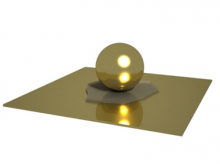 Nanoparticle-on-mirror plasmonic gaps Nanoparticle-on-mirror plasmonic gaps
We study the fundamentals of plasmonic system and their coupling to molecular systems featuring nm-gaps exclusively formed via self-assembly. Here we mainly use nanoparticle-on-mirror (NPoM) geometry for controlled and reproducible gaps.
|
| |
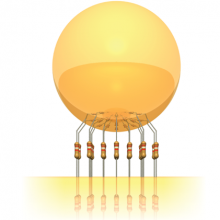 Conductive and quantum plasmonics Conductive and quantum plasmonics
Coupled plasmonic systems are similar to nanoscale plate capacitors with charges building up around the gap region. Only a small conductivity across this gap, either due to a conductive spacer or due to quantum tunnelling, disturbs this process by allowing a current to flow between the nanoparticle and the gold film. In this disturbed case new plasmonic modes emerge and evolve with changing conductivity, while at the same time the near-field intensity is greatly reduced due to screening by the currents.
Key papers:
Benz et al., Nano Letters 15, 669 (2015)
Benz et al., Opt.Exp. 23, 33255 (2015)
|
| |
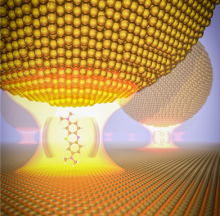 Single molecule strong coupling Single molecule strong coupling
Placing a single light-emitting molecule in a plasmonic gap changes its properties. We study the resonant electronic and vibrational coupling at the single-molecule level with carefully aligned molecular orientations in plasmonic nm-gaps using self-assembled monolayers. We aim to change the chemistry of single-molecules by modiyfing the coupling of electronic and vibrational states in <40nm3 plasmonic cavities and watch their dynamics in real time.
Key paper:
Chikkaraddy et al.,Nature (2016); DOI 10.1038/nature17974
|
| |
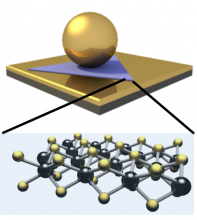 2D layered materials (TMCs) 2D layered materials (TMCs)
An ideal nano-spacer material to study plasmonic properties in nanostructures are 2D materials. Monolayers such as graphene, molybdenum disulphide (MoS2), or boron-nitride (BN) allow reliable fabrication of very robust sub-nanometre plasmonic junctions. We study and actively control plasmonic interactions in individual NPoMs by manipulating the systems morphology, which is dominated by the geometrical separation of plasmonic interface in the extreme case by just a single atom, and by addressing electronic interactions of 2D spacer material and plasmonic environment.
Key papers:
Mertens et al., ACS Nano 9, 825 (2015)
Sigle et al., J.Phys.Chem.Lett 6, 1099 (2015)
Tserkezis et al., Phys.Rev.A 92, 053811 (2015)
|
Previous Work
 |
plasmonically-enhanced solar cells
Using nanostructures which support strong localised plasmons, we are able to enhance the efficiency of ultrathin low cost solar cells by up to four times. This strategy can provide new routes to mass market photovoltaics.
|
 |
plasmonic rolls of plasmene
Just a single layer of graphene can be rolled up to into carbon nanotubes, we have created plasmene sheets which can be rolled up to create plasmonic tubes. The colours of these tubes change with their morphology, and they can be rolled and unrolled by shining on light.
|
 |
plasmonic sensing by Raman
Because the optical fields produced by plasmons are so strong, molecules in these fields can be detected extemely sensitively. The weak changes in colour of a scattered laser give the vibrational fingerprints of molecules. This allows to watch chemistry and nanoparticles on surfaces in exquisite detail.
|
 |
surface-enahanced CARS
The strong optical fields in plasmons also allow the enhancement of a traditional molecular sensing technique called CARS, which uses multi-colour pulsed lasers. We demonstrate a new technique which million-fold enhancements allowing direct imaging, for instance of biosamples.
|
References
[5] “Surface-Enhanced Coherent AntiStokes Raman Scattering on Nanostructured Au Surfaces”, Nano Lett 11, 5339 (2011)
[4] “From microns to kissing contact: dynamic positioning of two nanosystems”, App.Phys.Lett. 99, 053110 (2011)
[3] “Precise sub-nm plasmonic junctions within Au nanoparticle assemblies using CB glue”, ACS Nano 5, 3878 (2011)
[2] “Enhancing Solar Cells with Localised Plasmons in NanoVoids”, Opt. Exp. 19, 11256 (2011)
[1] “Dressing Plasmons in Particle-in-Cavity Architectures”, Nano Letters 11, 1221 (2011)
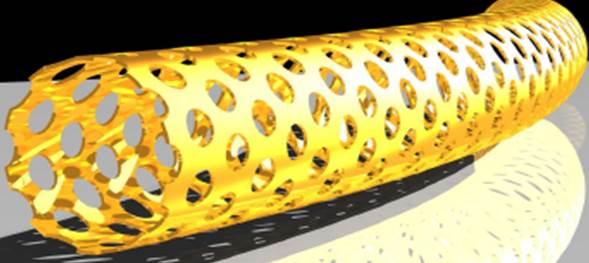









 2D layered materials (TMCs)
2D layered materials (TMCs) 